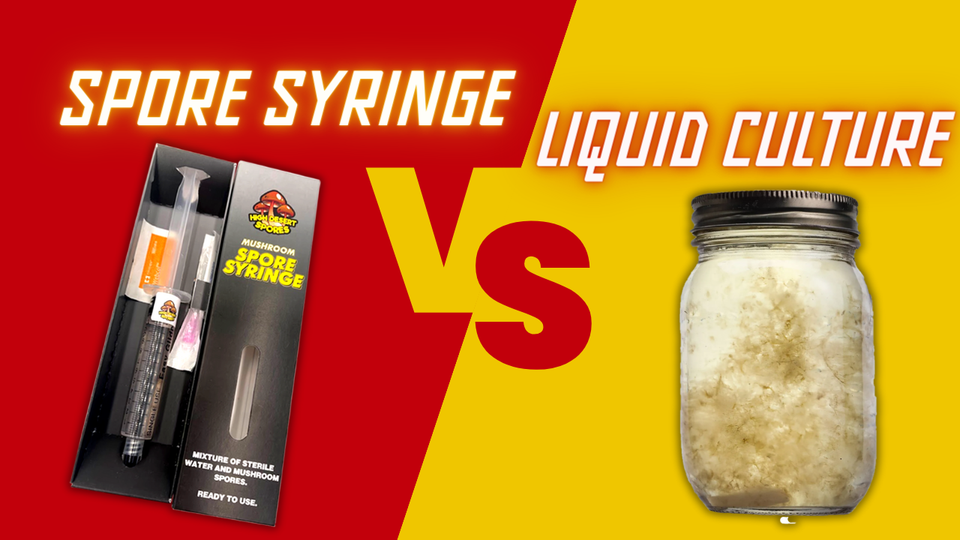Due to its fascinating process and satisfying outcomes, growing mushrooms has become more and more popular among both commercial growers and enthusiasts. Spore syringes and liquid culture are two popular techniques used to inoculate surfaces. The grower's experience, the type of mushrooms being grown, and other considerations all play a role in selecting the best approach, as each has pros and cons. The differences between liquid culture and spore syringes will be discussed in this article to help you decide which approach is ideal for your mushroom-growing ventures.
What is a Spore Syringe?
A spore syringe contains a sterile solution filled with mushroom spores suspended in water. Spores are the reproductive cells of fungi, similar to seeds in plants. Tons of spores, which can germinate and produce mycelium when placed in the right substrate, are normally contained in each spore syringe.
Advantages of Spore Syringes:
- Diversity and Genetic Variation:
- Spore syringes offer a broad genetic pool, which can lead to more resilient and diverse mushroom strains. This genetic variation can be beneficial for discovering new traits and enhancing strain robustness.
- Accessibility:
- Spore syringes are widely available and can be purchased from various online and local suppliers. They are often the starting point for beginner cultivators due to their ease of use and availability.
- Longer Shelf Life:
- Spores in a syringe can remain viable for several months to a year when stored properly in a cool, dark place. This makes them a good option for growers who do not plan to use them immediately.
Disadvantages of Spore Syringes:
- Longer Germination Time:
- It may take many weeks for spores to germinate and turn into mycelium, which is necessary before they can colonize the substrate. This lengthier germination time may be a disadvantage for farmers who want to see results more quickly.
- Higher Contamination Risk:
- Because spore syringes start from spores rather than established mycelium, there is a higher risk of contamination. The spores need to compete with other microorganisms in the substrate, increasing the chances of mold and bacterial growth.
- Unpredictable Results:
- Due to the genetic variation, spore syringes can produce inconsistent results. The mushrooms may vary in size, shape, and yield, making it challenging to achieve uniformity in commercial cultivation.
What is Liquid Culture?
Liquid culture consists of a nutrient-rich solution that has been inoculated with mushroom mycelium. Unlike spores, this mycelium is prepared to colonize a substrate more quickly since it is already actively growing. Spores or a fragment of mycelium can be incorporated into a sterile nutrient solution and allowed to grow to form liquid culture.
Advantages of Liquid Culture:
- Faster Colonization:
- Liquid culture contains live mycelium, which can immediately start colonizing the substrate upon inoculation. This results in significantly faster colonization times compared to spore syringes, often reducing the time to harvest by weeks.
- Lower Contamination Risk:
- Since liquid culture uses established mycelium, it has a lower risk of contamination compared to spore syringes. The mycelium can outcompete many contaminants, leading to healthier and more robust growth.
- Consistency and Predictability:
- Liquid culture allows for more consistent results. The mycelium used is usually from a single strain, leading to uniformity in mushroom size, shape, and yield, which is particularly advantageous for commercial growers.
Disadvantages of Liquid Culture:
- Shorter Shelf Life:
- Liquid culture has a shorter shelf life compared to spore syringes. It needs to be used within a few months, as the mycelium can deplete the nutrients in the solution and become less viable over time.
- Preparation and Maintenance:
- Creating and maintaining liquid culture requires more skill and equipment than using spore syringes. It involves sterilization processes and maintaining sterile conditions to prevent contamination during preparation and storage.
- Limited Genetic Variation:
- While the consistency of liquid culture can be an advantage, it also means there is less genetic variation. This can make the mushrooms more susceptible to diseases and environmental changes, as they lack the genetic diversity found in spore syringes.
Comparing Liquid Culture and Spore Syringe: Key Factors to Consider
- Experience Level:
- For beginners, spore syringes may be more accessible and easier to use. They require less initial setup and equipment, making them a good starting point. However, for more experienced growers looking for faster results and lower contamination risks, liquid culture is a better choice.
- Time to Harvest:
- If you are looking to reduce the time from inoculation to harvest, liquid culture is the preferred method. The established mycelium in liquid culture can colonize substrates much faster than spores.
- Scale of Cultivation:
- For commercial growers or those looking to produce a large quantity of mushrooms with uniform characteristics, liquid culture offers more predictable and consistent results. Spore syringes are suitable for hobbyists and small-scale growers who are exploring different strains and do not require uniformity.
- Contamination Control:
- Liquid culture is less prone to contamination compared to spore syringes. If contamination has been a recurring issue in your cultivation efforts, switching to liquid culture might help mitigate this problem.
- Genetic Exploration:
- If you are interested in exploring different genetic traits and potentially discovering new mushroom varieties, spore syringes offer a broader genetic pool. This can be a fascinating aspect of mushroom cultivation for those interested in mycology and breeding.
Practical Tips for Using Liquid Culture and Spore Syringe
Using Spore Syringes:
- Sterilize Everything: Ensure all equipment, including the syringe, substrate, and inoculation tools, are properly sterilized to minimize contamination risk.
- Proper Storage: Store spore syringes in a cool, dark place to maintain spore viability.
- Inoculation Technique: Use a still air box or laminar flow hood during inoculation to reduce exposure to airborne contaminants.
Using Liquid Culture:
- Prepare a Sterile Environment: Clean and sterilize all equipment and work in a sterile environment to prevent contamination.
- Monitor Growth: Regularly check the liquid culture for signs of contamination, such as unusual colors or odors, and discard any contaminated cultures.
- Storage Conditions: Store liquid cultures in the refrigerator to slow down mycelium growth and extend shelf life, but use them within a few months for best results.
Conclusion
In the context of mushroom growing, liquid culture and spore syringes both offer specific benefits and drawbacks. The best technique for you will depend on your demands, cultivation objectives, and level of experience. Spore syringes are great for novices and people who want to experiment with different strains because they provide genetic diversity and accessibility. Conversely, liquid culture works better for seasoned growers and businesses since it offers quicker colonization, reduced danger of contamination, and more reliable outcomes.
You may make an informed choice and improve your chances of success in growing mushrooms by being aware of the differences between these two approaches and taking into account the factors that matter most significant to you. Whether you choose the genetic diversity of spore syringes or the rapid colonization of liquid culture, each method offers its own path to a bountiful harvest of mushrooms.

